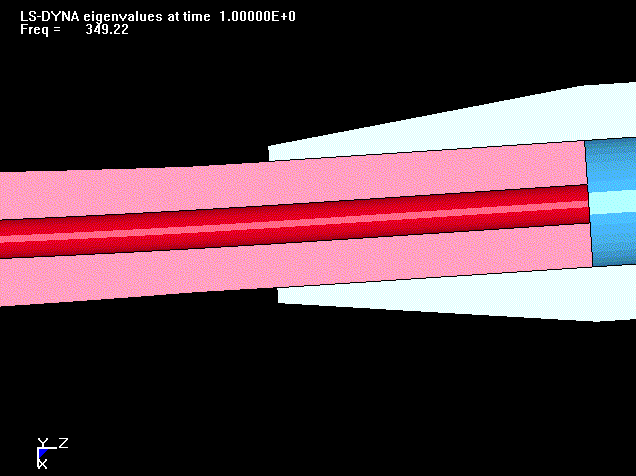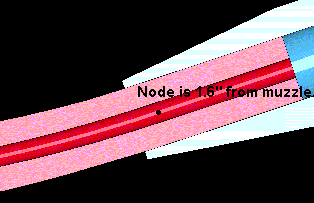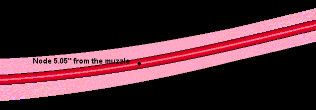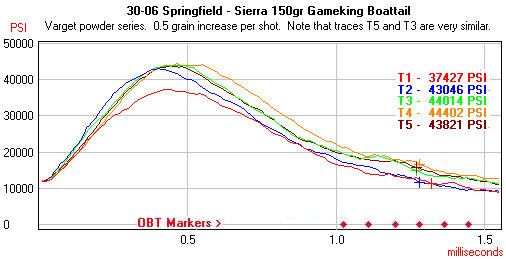

This analysis was done with the LS-DYNA Finite Element Code. This software is a very powerful tool for analyzing the dynamic and static loading of structures. It was used here to calculate the Vibration Mode shapes and Natural Frequencies of a rifle barrel with a tuner installed and with the tuner positioned at slight different positions. The breach end of the barrel was fixed in space which treats the barrel as a cantilever beam. There is a vertical plane of symmetry in the calculation and only motions in the vertical plane are calculated. The displacements are greatly amplified so that they can be viewed.
THE BARREL.... The 416 Stainless Steel barrel in this calculation has a breach diameter of 1.5" with a constant diameter for 4" and then a straight taper to a diameter of 0.8" at a distance of 20". Its diameter is 0.8" from there to the end of the barrel at 22". The caliber is 6mm with no rifling modeled. The 416 Stainless Steel tuner has an 0.8" ID and the OD is 1.5" and extends 2" beyond the muzzle in the initial position. This barrel weighs 6.61 pounds and the tuner weighs 1.11 pounds. Two additional calculations were done with the tuner moved 0.1" to the right and 0.2" to the right (farther from the breach). The breach end of the barrel is fixed to simulate the barrel's attachment to the rifle's action. For ease of generating the 3-D model, I did not include the cartridge chamber or the thread ligament.
HOW ACCURATE ARE THE CALCULATIONS?.... I have run a couple of test
cases comparing the FEA results with classical methods of analysis for mode
shapes and frequencies. The deflection (sag) calculated with FEA is checked for
accuracy. Accuracy Comparison.![]()
 Mode 1 - 80.304 Hz
Mode 1 - 80.304 Hz
 Mode 2 - 439.22 Hz
Mode 2 - 439.22 Hz
ADDING A TUNER.... Adding a tuner to the muzzle of a rifle barrel does
the following:
1. The additional mass reduces the amplitude of the vibrations.
2. Decreases the natural frequencies by decreasing the lower Mode's frequencies
more than the higher Modes.
3. Increases the barrel's vertical end sag due to the extra weight. This would
tend to make the vertical plane the preferred plane of vibration.
4. Moves the Mode 2 node closer to the muzzle.
![]() POSSIBLY MODE
SHAPES ARE NOT SO IMPORTANT.... I ran some FEA calculations of how a barrel
reacted to the high gas pressure and recoil. The forced deformations from the
high pressure gas and recoil cause the muzzle to change where it is pointing at
the target when the bullet exits the muzzlet. Click on the graphic to read the
info on Esten's rifle. Esten did extensive testing so that the FEA model could
be normalized to his test data.
POSSIBLY MODE
SHAPES ARE NOT SO IMPORTANT.... I ran some FEA calculations of how a barrel
reacted to the high gas pressure and recoil. The forced deformations from the
high pressure gas and recoil cause the muzzle to change where it is pointing at
the target when the bullet exits the muzzlet. Click on the graphic to read the
info on Esten's rifle. Esten did extensive testing so that the FEA model could
be normalized to his test data.

Click here or on the graphic to view the calculation
results.
| CONCLUSION.... Maybe the "consensus" was that a rifle barrel vibrated in one or more of the mode shapes when fired. That was because the mode shapes and frequencies were easy to calculate and they did seem to answer some of the questions. From these FEA dynamic pressure calculations, it appears that the recoil and forced deformations are much more important than the natural vibration modes in determining where a barrel is pointing when the bullet exits the muzzle. Then after the bullet exits the muzzle, the rifle barrel vibrates in its various natural frequencies and mode shapes. Put another way, consider a guitar string being plucked. One pulls the string into a position (forced position) then releases it and the string vibrates at is natural frequency. The recoil and bullet motions "pulls" the rifle barrel to a new shape and once the bullet leaves the barrel, then the barrel vibrates. However, the addition of the scope to the model has shown some small high frequency vibrations superimposed on the forced deformations, both of which, slightly alter where the muzzle points before the bullet exits. For lowering the amplitude of the high frequency vibrations, it appears that even an "out of tune" tuner is better than no tuner at all. |
COMPLEX VIBRATION.... The top animated gif is Mode 1 of the barrel with a tuner and the Mode 1 vibration frequency is 80.304 Hz. The bottom view is Mode 2 vibration that has a frequency of 349.22 Hz. The ratio of the frequency for Mode 2 to Mode 1 is approximately 4.34 to 1.0. I have tried to make the animations with that same frequency ratio so the viewer can visualize the complexity of what is occurring with the barrel and especially the displacement of the muzzle and the angle of departure of the bullet. In your mind's eye imagine the two modes of vibration going on at the same time with the amplitude of Mode 1 larger than Mode 2. As the larger swings of Mode 1 are occurring the smaller but faster amplitude swings of Mode 2 are superimposed on Mode 1.
ADJUSTING THE TUNER.... As the tuner is adjusted by moving it farther to the right on the barrel (farther from the breach), the frequencies of both modes decreases. Here is a table of the resulting Mode frequencies as the muzzle tuner is located at the original position and then moved to the right 0.1" and then 0.2". A separate calculation was done with the tuner removed as a base condition which has a much higher frequency in both Mode 1 and Mode 2 but a lower frequency ratio of Mode 2 to Mode 1 of 3.804. Not only does the tuner lower the frequencies, but it changes the ratio between the two frequencies.
Table 1: Mode Frequencies
| Tuner Position (in) |
Mode 1 (Hz) |
Mode 2 (Hz) |
Mode 3 (Hz) |
Ratio Mode 2/Mode 1 |
| Original Position | 80.304 | 349.22 | 919.47 | 4.349 |
| 0.1 Shifted Right | 79.568 | 345.77 | 910.22 | 4.346 |
| 0.2 Shifted Right | 78.837 | 342.38 | 901.13 | 4.343 |
| None | 130.91 | 498.00 | 1200.1 | 3.804 |

MODE 2 NODE LOCATION.... For the tuner in the original position, the node where the barrel's center line stays on the original axis is 1.60" back toward the breach from the muzzle. You can view the location in the animated gif picture. Find the node location by putting your mouse pointer on the center of the bore and move it to the right or left until the vertical motion of the center of the bore remains fixed behind the mouse pointer. The tuner mass would have to be moved much farther away from the breach to cause the node to be located at the muzzle.

BARREL SLOPE AND CURVATURE.... In this view, I placed a dot approximately at the node point. At the muzzle upward swing of Mode 2, the slope (first derivative of displacement) of the barrel is positive on both sides of the node. The change in slope or curvature (second derivative of displacement) is also positive on both sides of the node. The bore is not parallel to the axis at the node location. The only time the bore is parallel to the original axis is when the barrel swings through the rest position. At that time, of course, every point on the barrel is parallel to the axis. The same is true for Modes greater than Mode 2, at each central node. The bore is always parallel to the axis at the anti-nodes (minimum and maximum) points between the nodes.
SIMPLY WRONG.... There is an article on the web from the Precision Shooting Magazine that is wrong about how a barrel vibrates. Here is the article: I'm Feeling Those Good Vibrations, AGAIN! A barrel tuner can improve accuracy but this article is wrong about how a barrel vibrates and how tuners work.
EXIT ANGLE.... If the tuner were long enough to cause the node of Mode 2 to be located at the muzzle, the muzzle would still have the variations in exit angle and the exit angle would not be parallel to the original bore axis, except when the barrel passes through the rest position twice on each cycle.

BARREL SLOPE WITH NO TUNER.... The dot is approximately at the node point. Zooming in at the Mode 2 node while at the muzzle's maximum upward swing, the upward slope and positive curvature is more obvious in the barrel without the tuner.
Table 2: Mode 2 Node Location
| Tuner Position (in) |
Node Distance from Breach (in) |
Node Distance from Muzzle (in) |
Muzzle Sag (in) |
| Original Position | 20.40 | 1.60 | 0.00233 |
| 0.1 Shifted Right | 20.45 | 1.55 | 0.00237 |
| 0.2 Shifted Right | 20.58 | 1.42 | 0.00241 |
| None | 16.95 | 5.05 | 0.00106 |
 Mode 1 -
130.91 Hz
Mode 1 -
130.91 Hz
 Mode 2 -
498.00 Hz
Mode 2 -
498.00 Hz
TUNER REMOVED.... For a base condition, here are the first two vibration Modes for the same barrel with the Tuner removed. The barrel vibrates with approximately a 38% higher frequency with the Tuner removed. The vibration frequency of Mode 2 is slightly less than four times that of Mode 1. The Mode 2 node is much farther back from the muzzle.
Possible explanation of how a tuner could improve accuracy
MUZZLE POSITION.... The Tuner lowers the frequencies of each Mode so that the muzzle could be just approaching the upper extreme of its swing at the time the bullet exits. The Tuner also adds weight to the barrel's muzzle which increases the vertical deflection (sag). More sag before firing would make the barrel more likely to vibrate in the vertical direction.
MUZZLE EXIT ANGLE.... Tuner changes the frequency of each mode when it is adjusted and not at the same rate. The exit angle is probably more important to shot placement than the vertical position of the muzzle. The Tuner could be adjusting the muzzle exit angle so that when the deflections of Mode 1 points up, the Mode 2 is pointing down. This could be happening at the top or bottom of the Mode 1 muzzle swing.
TIMING.... The approximate time that it takes a 3300 fps
muzzle velocity bullet to exit the barrel, assuming a constant acceleration, is
0.0011 seconds. Actual exit times would be longer since the bullet is not under
constant acceleration and the time from the firing pin first hitting the primer,
ignition starts, is not included.

The view is a typical pressure vs. time trace from Recreational
Software, Inc. Note that the zero time starts at a 12,000 psi pressure and
bullet exit is somewhere near the + signs. The primer ignition was at an earlier
time. The velocity of sound in 416 stainless steel is 14,900 fps and a stress
wave has time to propagate up and back the full length of the barrel 4 or more
times after ignition and while the bullet is traveling within the barrel. The
muzzle end of the barrel has ample time to "know" that something is
going on at the breach end before the bullet exits.
VIBRATION PERIOD.... As an example, assume a mode 1 frequency of approximately 100 Hz that has a period of vibration of 0.010 seconds. Therefore the time it takes the barrel to make its first upward swing is a fourth of a period or about 0.0025 seconds. This is the approximate time the bullet exits. The mode 2 vibration has a period of approximately 0.0002 seconds and could be at the top of its thirteenth upward swing, at the 12.25th period swing, or about 0.0025 seconds. These two modes could add and amplify the exit angle of the muzzle near the peak of its upward swing, just as the bullet exits. The tuner could be adjusted to slightly change the two frequencies so that they reinforce each other at the time of bullet exit.
FINDING THE SWEET SPOT.... When tuning a load to a
particular rifle, possibly the sweet spot is not when the bullet exits the
barrel at the maximum of the vibration's upward swing but, slightly before
the maximum height or exit angle of the upward swing.
UPWARD SWING.... The vertical amplitude of vibration is more heavily
excited than the horizontal vibration because the center of gravity of the rifle
is located below the barrel's centerline and the bullet's travel down the barrel
causes a vertical turning moment about the rifles center of gravity. The
vertical vibration is most important. Also, the barrel is initially slightly
deflected downward due to gravity. When the round is fired, the pressure also
tends to straighten the barrel like a bourdon tube in a pressure gage. As the
barrel straightens, it over shoot in the upward direction and this adds to the
excitation of the Mode 1 vibration. As a side note, the axial extension
vibration mode is also probably heavily excited. This is the mode where the
barrel extends and shortens axially. But, this axial mode should only have a
negligible affect accuracy.
AVERAGE VELOCITY BULLET.... Possibly the sweet spot occurs when the
bullet, with the average velocity, for a particular load, exits the barrel just
before the peak of its upward swing.
FASTER BULLET.... A faster bullet will exit the barrel earlier and exit
slightly before the average velocity bullet and the angle of the upward swing of
the barrel will be slightly less. So the bullet's launch angle is slightly less,
but the bullet is going faster and drops less.
SLOWER BULLET.... A slower bullet will exit later and the barrel's
vertical swing will be higher and at a steeper angle when the slower bullet
exits. The bullet is launched at a higher angle but is slower and will drop
slightly more.
This combination, within limits, would print the bullet at about the same
vertical location on the target for the normal variations in velocity from round
to round.
 Mode 1 -
80.304 Hz
Mode 1 -
80.304 Hz
 Mode 2 -
439.22 Hz
Mode 2 -
439.22 Hz
 Mode
3 - 919.5 Hz
Mode
3 - 919.5 Hz
 Mode
4 - 1790 Hz
Mode
4 - 1790 Hz
 Mode
5 - 2374 Hz
Mode
5 - 2374 Hz
FIRST FIVE MODE SHAPES.... These are the first five vibration Mode shapes, in the vertical plane, that the barrel and tuner undergo when excited. The displacements are shown here greatly amplified so the shape change can be easily seen. The actual displacements are very small and even smaller at the higher frequency Modes.
Good Hunting... from Varmint Al![]()
For the serious reader: How to
Check Another Engineer's Calculation.![]()
More info on Modal
Analysis.
Last Updated: 02/08/2013
End of Page![]()